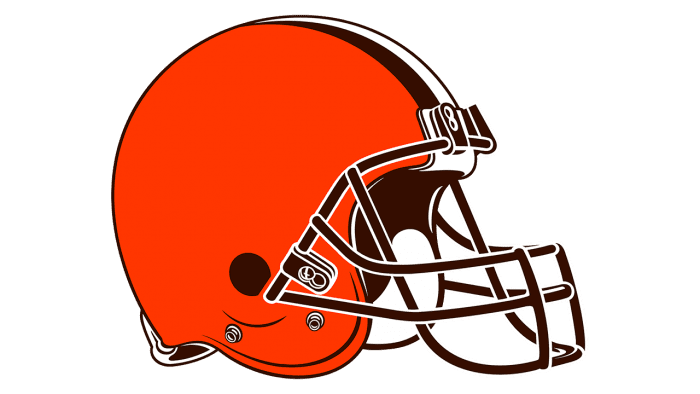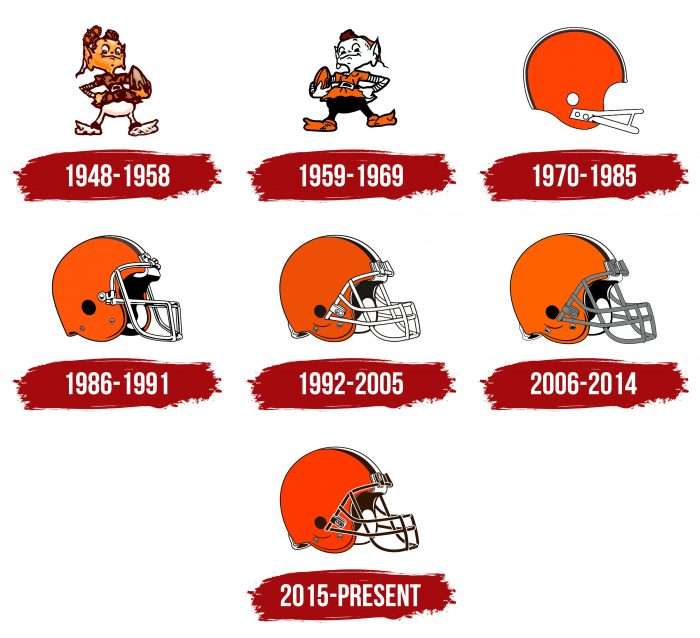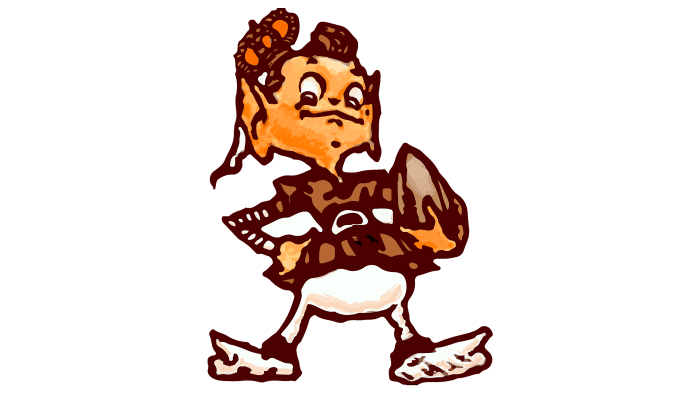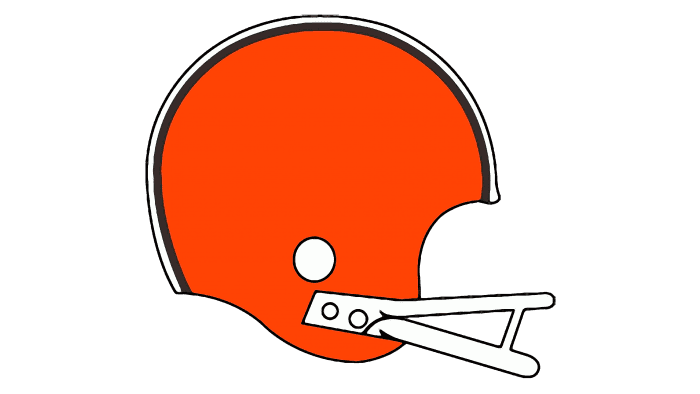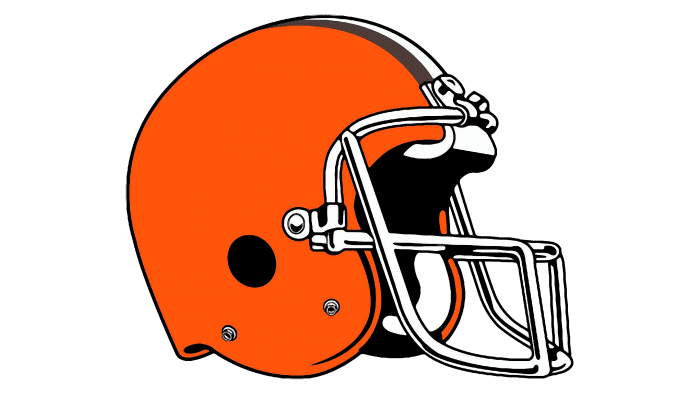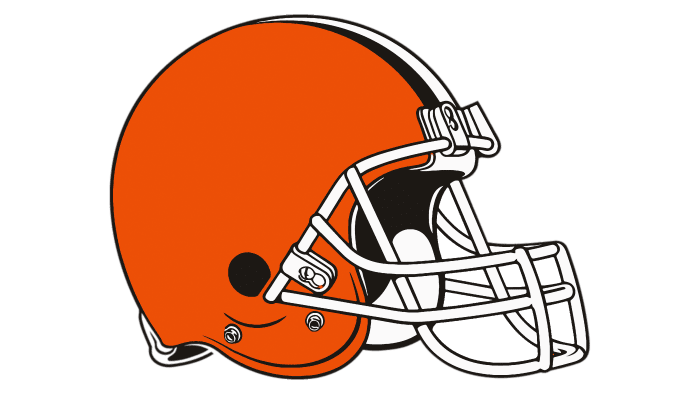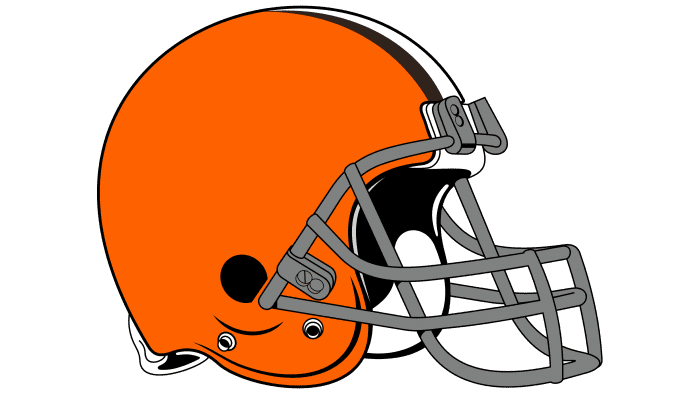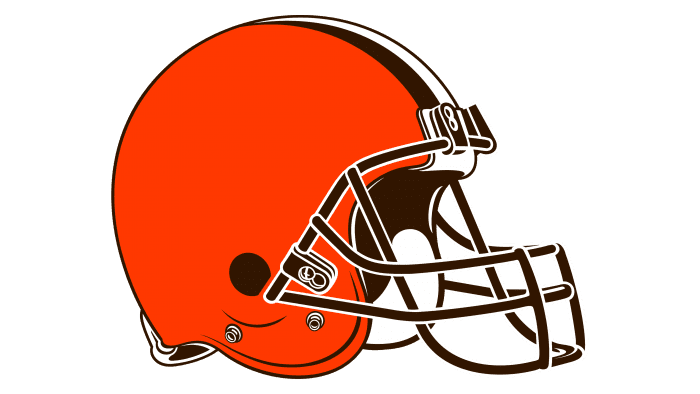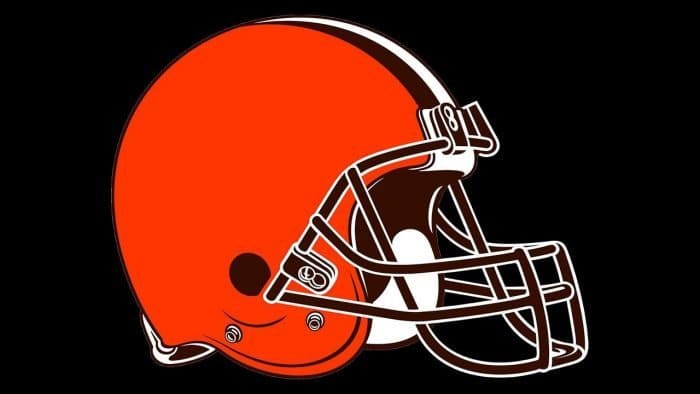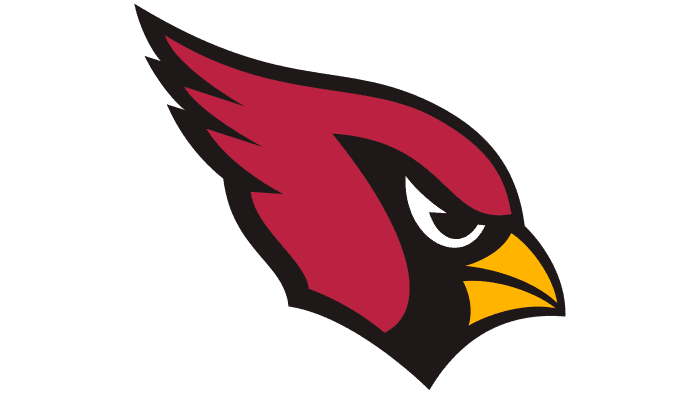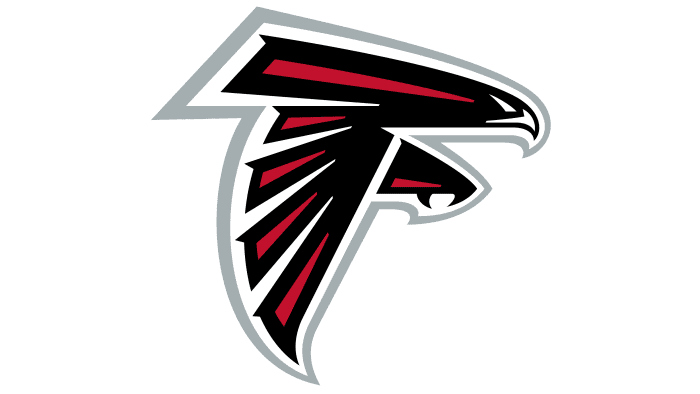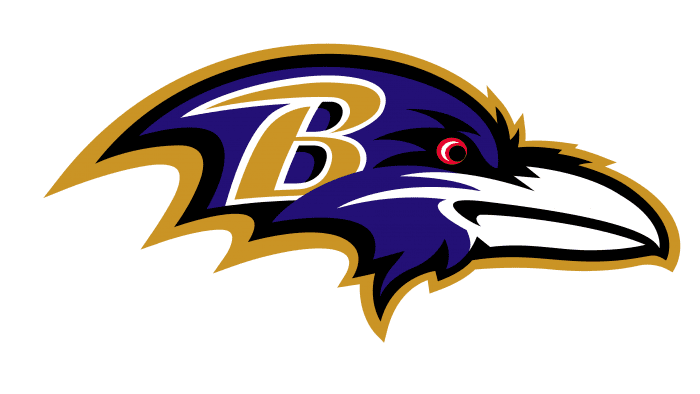The emblem of the football club founded in 1948 demonstrates a commitment to its history. Over more than half a century, the Cleveland Browns logo has changed only in detail, reflecting modern evolution, and the name has become a tribute to the first coach.
Cleveland Browns: Brand overview
| Founded: | June 4, 1944 |
| Founder: | Jimmy Haslam, Dee Haslam |
| Headquarters: | Cleveland, Ohio, U.S. |
| Website: | clevelandbrowns.com |
The Cleveland Browns are a professional football club based in Cleveland; they compete in the National Football League as a member of the AFC North division. Its history began in 1944 when sports editor Arch Ward decided to create the All-America Football Conference and selected eight potential team owners.
One of them was Cleveland businessman Arthur B. McBride. After purchasing the franchise, he asked sports writer John Dietrich to hire a coach. Dietrich proposed Paul Brown. In 1945, Paul received a share of the football club’s stocks and became its co-owner.
Fans wanted the team to be called the Browns, but the coach rejected this idea. Then McBride organized a contest for the team’s name and promised to give the winner a $1,000 war bond. In June 1945, the committee chose the nickname “Panthers,” which lasted two months. Paul Brown rejected it because the old name “Cleveland Panthers” had been unsuccessful.
McBride yielded to public demand and named the team “Browns.” He didn’t want to argue with the coach, so he invented an urban legend that the Cleveland Browns were named after the boxer Joe Louis, also known as the Brown Bombers. Paul never adhered to the alternative story and admitted they were named in his honor.
In 1953, McBride sold the team to a group of Cleveland businessmen for $600,000. These businessmen were Sol Silberman, racetrack owner; Homer Marshman, lawyer; Ellis Ryan, former president of the “Indians”; and Dave R. Jones, former director of the “Cleveland Indians.” In 1961, Dave sold the team to a group led by advertising director Art Modell. Bob Gries, who once owned a share of the Cleveland Browns, received 40% of the stocks.
In 1995, Art Modell announced plans to move the team to Baltimore. He encountered a fierce lawsuit and was forced to make an interesting compromise. Modell was allowed to keep the “Browns” players’ contracts, but he had to create a new franchise. Today, this organization is known as the Baltimore Ravens. The “Browns'” intellectual property, including the team name, logos, training center, and history, was transferred to a trust.
The NFL temporarily deactivated the old franchise in February 1996. The Browns resumed playing in 1999 under new owner Al Lerner. Four years later, he died, and his son, Randy Lerner, took over the Browns franchise. On August 2, 2012, Randy sold the “Browns” to businessman Jimmy Haslam for 1 billion dollars.
Meaning and History
Over more than 70 years, the “Cleveland Browns” had seven logos, not counting one unused. Their evolution can be divided into two periods: before and after 1969. The first period is the so-called Brownie Elf era, which artist Dick Dugan depicted in cartoon style and “awarded” a football.
The second period is the longest. It began in 1970 when the team first used the emblem of an orange helmet. This version changed several times: developers pursued a modern design so that the drawn sports attribute corresponded to reality.
What is Cleveland Browns?
The Cleveland Browns joined the AFC North in 2002. They have been competing in the National Football League since 1950, and before that, they participated in the All-American Football Conference. The club’s history had a brief hiatus when Arthur Bertram Modell decided to move the club members to Baltimore but leave all the “Browns” legacy in Cleveland. The original franchise was restored in 1999.
1948 – 1958
The debut logo of the “Cleveland Browns” features the original character Brownie Elf. Its name is a play on words: “Brownie” is consonant with the team’s nickname “Browns.” The image’s authorship belongs to artist Dick Dugan, who became a sports cartoonist for the Cleveland Plain Dealer.
The elf stands with a football in his left hand. On his head is a crown – a symbol of power. The figure is turned to the left. All elements have a dark outline with ragged edges. The design of this logo reflects the classic style of animation.
1959 – 1969
In 1959, Brownie Elf changed:
- He was turned to the right.
- The royal crown was replaced with a cap.
- The football was in his right hand.
His clothes became black and orange, and his hands and face were white. Shadows characteristic of animated images were removed. The character is depicted schematically, without detailed elaboration, and outlined in black.
1965 (unused)
When Art Modell bought the franchise, he deemed the Cleveland Browns emblem too childish and discarded it. In the mid-1960s, a new logo was created: a dark orange helmet with a white stripe on top and a black outline.
This sports form is depicted from the side. It has a gray face shield and is adorned with intersecting letters “CB” in brown color with a white outline, symbolizing the city and nickname – Cleveland Browns. The font does not contain serifs. This version of the Cleveland Browns emblem was never used in games.
1970 – 1985
After the AFL and NFL merger in 1969, the football club left the cartoonish Brownie Elf in the past. In 1970, they used a logo similar to the unused 1956 version. Only minor changes were made:
- Three gray dots were removed.
- The inner black outline was widened.
- The face mask became white.
They removed the “CB” inscription because the “Cleveland Browns” stopped decorating helmets with the team brand and decided to make it their trademark.
1986 – 1991
In the new Cleveland Browns logo, designers discarded the usual side view and made a ¾ view. The change in perspective allowed for a detailed 3D drawing of the face mask. Dark lines running along the white fittings emphasize the three-dimensionality. The top part of the helmet has a double white-gray stripe. The orange color became one shade darker.
1992 – 2005
In 1992, another modification of the Cleveland Browns logo was approved. Designers made the shape of the face mask more modern. The colors remained the same, only becoming more muted. A new element appeared at the bottom – a round white protrusion.
2006 – 2014
In 2006, the “Cleveland Browns” abandoned the boring color scheme and returned to the orange color. The only change in this logo is that the face mask became gray. The shapes, ratios, and thickness of the stripes did not change.
2015 – today
The current logo is the result of a long evolution of the helmet, first presented in 1970. Its creators tried to preserve the main elements, such as the two black and white stripes at the top. In addition, they adhered to the original palette, in which bright orange color always predominated.
The current brand name was adopted in 2015. It features the same helmet that has become an integral part of the players’ equipment and part of the visual identity of the Cleveland Browns.
Cleveland Browns: Interesting Facts
The Cleveland Browns are a football team from Cleveland, Ohio, with a lot of history and fans who care about them.
- How They Started: The Browns began in 1946 and joined the NFL in 1950. They’re named after Paul Brown, their first coach and one of the team’s creators.
- Winning Early On: The Browns were good from the start. They won championships in another league before joining the NFL and then kept winning, grabbing eight league championships. They haven’t won a Super Bowl yet, though.
- Dawg Pound: Their fans are called the “Dawg Pound” because they are loud and proud, especially when cheering for the team’s defense. They sit in a special part of the stadium and are known for being super enthusiastic.
- Their Helmets: The Browns’ helmets don’t have a logo, which is different from every other NFL team. They’re just orange with a brown-and-white stripe, which shows the team likes to keep things simple.
- The Move and Comeback: In 1995, the team’s owner wanted to move them to Baltimore, which upset many people. But they worked out a deal where the team’s history and colors stayed in Cleveland, and the Browns came back to play in 1999.
- Famous Players: They’ve had some amazing players, like Jim Brown, one of the greatest of all time and a Pro Football Hall of Fame member.
- Breaking Barriers: The Browns were the first NFL team to start an African American quarterback in a season opener when Marlin Briscoe played for them in 1968.
- A Parade for Losing: After a season where they didn’t win any games in 2017, the fans had a parade. It was a funny way to show they still supported the team no matter what.
- Big Rivalries: They have big games against other teams in their division, like the Pittsburgh Steelers, Cincinnati Bengals, and Baltimore Ravens. These games are always exciting because of the long history between the teams.
The story of the Cleveland Browns shows how a team and its fans stick together through good times and bad, making them a special part of the NFL.
Font and Colors
For all NFL teams, the helmet is an important sports attribute. But for the Cleveland Browns, it means much more since it has been depicted on emblems since 1970. The drawn helmet looks almost like in reality if you close your eyes to the maximally authentic style. Artists paid attention to details: the exact shape of the headgear, the number and location of the bars in the protective mask, and the fastenings, so everything is close to reality.
There is not a single inscription on the helmet or around it. And that’s because the owners of the Cleveland Browns consider it unnecessary to mention the team’s name – in their opinion, the logo is quite recognizable by itself and does not need textual additions.
This is indeed the case if you pay attention to the color combination. The iconic orange helmet with dark brown and white details is currently associated with only one NFL football club. At least until it completely changes or repaints its iconic logo.
Cleveland Browns color codes
| Brown | Hex color: | #311d00 |
|---|---|---|
| RGB: | 49 29 0 | |
| CMYK: | 1 33 85 94 | |
| Pantone: | NFL Cleveland Browns (Custom PMS) |
| Orange | Hex color: | #ff3c00 |
|---|---|---|
| RGB: | 255 60 0 | |
| CMYK: | 2 93 100 0 | |
| Pantone: | PMS 2028 C |
FAQ
What does the Cleveland Browns logo represent?
The Cleveland Browns logo is an orange helmet without any distinguishing marks because the club’s players are the only ones who wear helmets without graphics and inscriptions. Only the top part of the headgear is adorned with a white stripe.
What does “Browns” mean in the translation from English Cleveland Browns?
It is a tribute to Paul Brown, who was one of the founders and the first coach of the team. He spent a lot of time with the Cleveland Browns before the NFC and AAFC merger.
What is Cleveland’s brown mascot?
The football club’s mascot is Brownie Elf. It’s a funny little man in an orange shirt with striped sleeves and a large cap. His distinctive ears are pointed. No one knows where this cartoon character came from, and even research has not yielded results.
Where did the name Cleveland Browns come from?
The name Cleveland Browns was proposed by fans in a contest for the best name. Thus, they decided to immortalize the name of the club’s first coach – Paul Brown.
